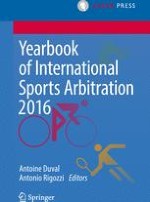
2018 | OriginalPaper | Chapter
Back to the Future: The First CAS Arbitrators on CAS’s First Award (TAS 86/1, HC X. c. LSHG) and Its Evolution Since Then
Author : Erika Hasler
Published in: Yearbook of International Sports Arbitration 2016
Publisher: T.M.C. Asser Press
Activate our intelligent search to find suitable subject content or patents.
Select sections of text to find matching patents with Artificial Intelligence. powered by
Select sections of text to find additional relevant content using AI-assisted search. powered by